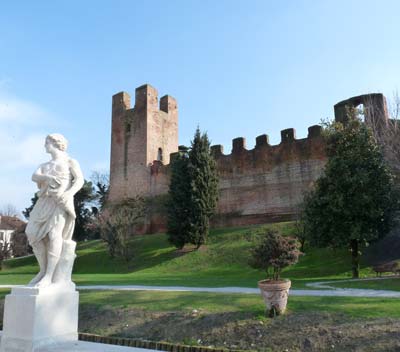About Castelfranco Veneto
Castelfranco Veneto is a small historic walled town in the Veneto region of northern Italy, in the province of Treviso (Provincia di Treviso). Its population is approximately 30,000. The town is situated between Treviso and Vicenza, and is on a regional railway line between Venice and Bassano del Grappa. It’s called Castelfranco Veneto to differentiate it from other Italian towns called Castelfranco, including one in Emilia-Romagna. The town has a small historic core which is surrounded by high defensive walls. It’s an attractive place to wander for an hour, and has a few sights which tourists can visit. There’s not enough here for a full day out, but it combines well with other villas and towns nearby to make part of an interesting itinerary. The public transport links are good, so you can explore the area without a car.
The site was developed and fortified by Treviso in 1195; its central area, the Castello consisting of a large square fortification with high walls and a moat. Nowadays this fortress, criss-crossed by a few streets, is the heart of Castelfranco.
Find and book hotels. With location maps and guest reviews.
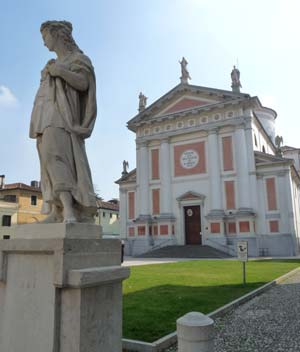
Tourist sights
The walled part of Castelfranco Veneto is very small, containing just a few streets: like an enlarged fortress. At its heart, naturally, is the town’s cathedral, the Duomo, which sits grandly behind a row of statues opposite the town hall. The present-day Duomo is a large eighteenth-century building, designed by Francesco Maria Preti who also designed the grand Villa Pisani at Strà. The church’s greatest treasure, though, is older than the building. This is the town’s prize attraction: an altarpiece by Giorgione, who was born here and whose statue stands outside the walled town overlooking a piazza named in his honour. The painting (Pala di Giorgione) is displayed in a side-chapel on the right (more below). You should also visit the vestry (sagrestia) on the left of the nave, to admire a collection of local paintings including some lovely pieces of fresco by Paolo Veronese, which were removed from a country villa. The room is kept locked: ask for admission. The Duomo is open 9am-12pm and 3pm-6pm; closed during Mass.
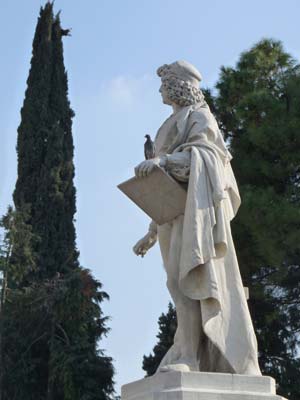
Giorgione (‘Big George’) is thought to have been born in Castelfranco Veneto in around 1478, and died in Venice in 1510. His extant works are few but very important, and renowned for their enigma. They include the famous Tempest in the Accademia Gallery in Venice. The altarpiece in the Duomo dates to arround 1503-1504. It was commissioned by a local condottiere after the death of his son. In the foreground are the Virgin and Child, alongside St. Francis and St. Nicasius. In the background is a countryside scene with a fortified town and two small figures of soldiers. The painting was stolen in 1972, but subsequently recovered and has recently been carefully restored.
Next door to the Duomo is the so-called Casa del Giorgione (‘House of Giorgione’). Although it was once claimed that the artist was born in the building, there is no supporting evidence. However, the house has been restored and opened to the public by the local council (there’s an admission charge). The interior is fairly bare, but contains some attractive remnants of fresco, including a long allegorical frieze which could be attributed to Giorgione. Opening hours are 10am-12.30pm and 3pm-6.30pm; closed Mondays and some public holidays.
Down the street opposite the Duomo is another of the town’s interesting buildings, the Teatro Accademico, which was also designed by Preti in the eighteenth century.
Once you have seen these principal sights it’s worth having a wander along the little arcaded streets so typical of the Veneto region. The Torre Civica, a clocktower above the eastern gate, bears the Venetian winged lion and is surmounted by a little dome.
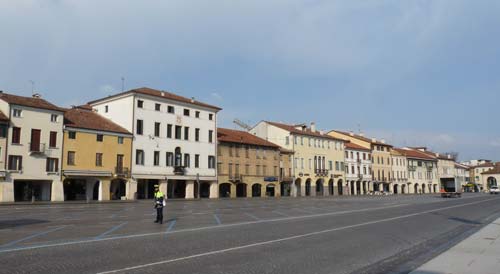
Ignoring the busy roads you can stroll around the exterior of the fortifications, where there is a pretty little park (in the northern corner). A bustling market fills Piazza Giorgione on Tuesdays and Fridays selling everything from fruit and vegetables to towels. There are several interesting lanes and shops, some in attractive and well-maintained little courtyards.
Outside the clocktower gate are some fine buildings, some with external frescoes still visible. If you are walking from the station, this is the first part of the town centre you’ll reach. A short walk along Borgo Treviso is the Villa Revedin Bolasco. Its garden, the Parco Revedin Bolasco is open to the public, although it has limited opening times and closes during rainfall. Current opening times: Tuesdays and Thursdays 10-12 and 3-5.30; weekends 10-1 and 2.30-5.30. Between June and September the park stays open an extra 2 hours in the evening, but doesn’t open until 3.30pm on weekend afternoons.
Eating, planning and practicalities
The town’s tourist information centre is set into the town walls at the western end of the main street, Via FM Preti. Chances are, if you’ve walked from the railway station you’ll already have passed most of the town’s sights. Still, they have useful maps of the town and area as well as generous supplies of local information in several languages including English. The Provincia di Treviso is plainly keen to woo foreign visitors and has invested considerably in promotional literature. A very helpful girl on duty provided useful advice, recommended other towns nearby, and printed out train times.
As with most Italian towns, consider an early start or an afternoon visit. The sights and the tourist information office all close for a long lunch in the middle of the day. There are quite a few appealing bars and several enticing restaurants dotted around the historic centre and the surrounding streets, where you too could enjoy a leisurely meal. For a quicker lunch, you could try a slice of takeaway pizza, a picnic in the park by the walls (see above), or visit one of the bars which offers rolls or light lunch dishes, which will usually be cheaper and swifter than eating in a restaurant. On my first visit I had a plate of pumpkin-filled tortelloni and a freshly-squeezed orange juice for 8.70 in the Caffè-Bar Grappolo d’Oro in Piazza Giorgione outside the walls (closed Thursdays). When I returned for the big Giorgione exhibition, I ate at the handy Bistro San Giustino, which is right on the corner by the Duomo and serves cheap meals, sandwiches and snacks to locals and visitors. I feasted on pasta, sitting next to a suit of armour. Two courses, wine and water cost 11.
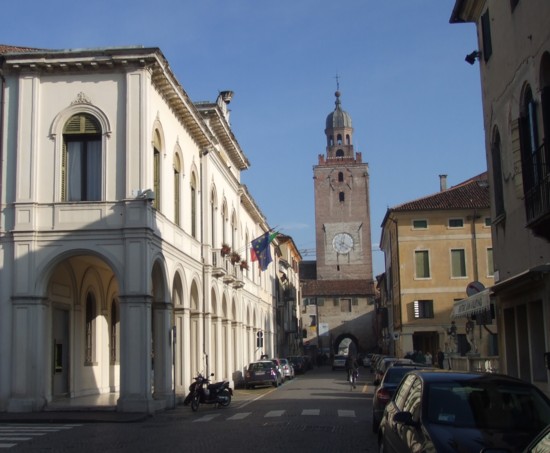
Getting to Castelfranco Veneto
Castelfranco Veneto has good transport connections. It is undeniably simpler to hire a car and tour the region at your own pace, stopping off at villas and villages on a whim. But public transport is still a viable option, spares you from tackling the Italian roads, integrates you more into Italian life and is ethically sounder.
By train: Castelfranco is something of a hub on the regional railway network, with direct trains to Vicenza, Treviso, Venice and Bassano del Grappa. Venice is just under an hour away on the slow regional line; single tickets cost 3.40 at the time of writing. The railway station is around fifteen minutes’ walk from the heart of town; there is a map displayed on a board opposite the station to help you get your bearings. Taking the street directly opposite (Via Brigata Cesare Battisti) and turning left at the end will take you past Villa Revedin Bolasco and on to the walled town centre. An alternative route is to head left outside the train station and then take a right along Borgo Pieve.
By bus: Buses between Treviso, Castelfranco, Cittadella and Vicenza are run by a firm called La Marca – see links panel for their timetables (orari). More local services, centred on Castelfranco, are run by CTM. The bus station (autostazione) is to the west of the centre, on Via Podgora.
By air: The nearest airport is Treviso Airport, served by Ryanair (as ‘Venice Treviso’). The main airport for Venice, Marco Polo Airport, is also convenient for this part of the Veneto.
Things to do around Castelfranco Veneto
The rail connections make it fairly easy to combine Castelfranco with another local destination for a full day out. Cittadella, under a quarter of an hour away by train, is a good additional destination – another walled town, this time circular, where you can walk around the restored walls. The Villa Emo, one of the Veneto’s most famous grand country villas, is a short train trip from Castelfranco. The little town of Asolo, beloved of Robert Browning, is also in easy reach. The town’s tourist information office has a good stock of information on the surrounding area with lots of additional suggestions. Larger towns of interest nearby include Vicenza, Treviso, Padua, Bassano del Grappa, and of course Venice.
Castelfranco Veneto accommodation
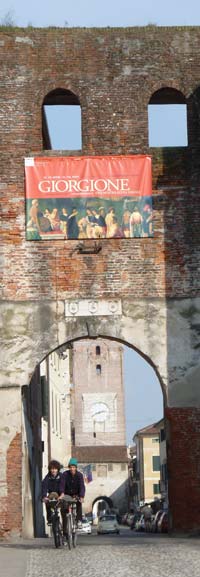
With its pleasant atmosphere and choice of bars and restaurants, Castelfranco Veneto would make an agreeable base for a night or two for travellers touring this area of the Veneto and visiting local villas and towns. The good four-star Hotel Alla Torre is in a great position by the town walls, and there’s also a comfortable and central three-star hotel, the Best Western Albergo Roma.
> Castelfranco Veneto hotels and B&Bs
On this site
Veneto art & architecture itinerary
Useful external links
Blog article about visiting the 2010 Giorgione exhibition
Giorgione (Wikipedia)
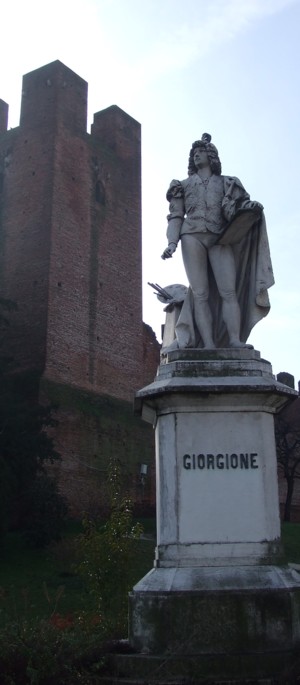
Veneto destinations
- Veneto region
- Abano Terme
- Asolo
- Bassano del Grappa
- Brenta Canal
- Caorle
- Castelfranco Veneto
- Chioggia
- Cittadella
- Concordia Sagittaria
- Conegliano
- Cortina d’Ampezzo
- Lido di Jesolo
- Malcesine
- Marostica
- Monselice
- Montegrotto Terme
- Padua
- Portogruaro
- Rovigo
- Sottomarina
- Treviso
- Venetian Lagoon
- Venice
- Verona
- Vicenza
- Veneto art & architecture itinerary
- Veneto villas – Vicenza: La Rotonda & Villa Valmarana ai Nani
- Veneto villas – Villa Pisani & Villa Foscarini Rossi, Strà
- Venice Airport
- Treviso Airport
